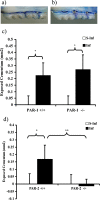Protease-activated receptor 2 has pivotal roles in cellular mechanisms involved in experimental periodontitis
- PMID: 19933835
- PMCID: PMC2812191
- DOI: 10.1128/IAI.01019-09
Protease-activated receptor 2 has pivotal roles in cellular mechanisms involved in experimental periodontitis
Abstract
The tissue destruction seen in chronic periodontitis is commonly accepted to involve extensive upregulation of the host inflammatory response. Protease-activated receptor 2 (PAR-2)-null mice infected with Porphyromonas gingivalis did not display periodontal bone resorption in contrast to wild-type-infected and PAR-1-null-infected mice. Histological examination of tissues confirmed the lowered bone resorption in PAR-2-null mice and identified a substantial decrease in mast cells infiltrating the periodontal tissues of these mice. T cells from P. gingivalis-infected or immunized PAR-2-null mice proliferated less in response to antigen than those from wild-type animals. CD90 (Thy1.2) expression on CD4(+) and CD8(+) T-cell-receptor beta (TCRbeta) T cells was significantly (P < 0.001) decreased in antigen-immunized PAR-2-null mice compared to sham-immunized PAR-2-null mice; this was not observed in wild-type controls. T cells from infected or antigen-immunized PAR-2-null mice had a significantly different Th1/inflammatory cytokine profile from wild-type cells: in particular, gamma interferon, interleukins (interleukin-2, -3, and -17), granulocyte-macrophage colony-stimulating factor, and tumor necrosis factor alpha demonstrated lower expression than wild-type controls. The absence of PAR-2 therefore appears to substantially decrease T-cell activation and the Th1/inflammatory response. Regulation of such proinflammatory mechanisms in T cells and mast cells by PAR-2 suggests a pivotal role in the pathogenesis of the disease.
Figures








Similar articles
-
Mast Cells Contribute to Porphyromonas gingivalis-induced Bone Loss.J Dent Res. 2016 Jun;95(6):704-10. doi: 10.1177/0022034516634630. Epub 2016 Mar 1. J Dent Res. 2016. PMID: 26933137
-
GM-CSF and uPA are required for Porphyromonas gingivalis-induced alveolar bone loss in a mouse periodontitis model.Immunol Cell Biol. 2015 Sep;93(8):705-15. doi: 10.1038/icb.2015.25. Epub 2015 Mar 10. Immunol Cell Biol. 2015. PMID: 25753270
-
Effect of a protease-activated receptor-2 antagonist (GB88) on inflammation-related loss of alveolar bone in periodontal disease.J Periodontal Res. 2023 Jun;58(3):544-552. doi: 10.1111/jre.13120. Epub 2023 Mar 31. J Periodontal Res. 2023. PMID: 37002616
-
Involvement of T-lymphocytes in periodontal disease and in direct and indirect induction of bone resorption.Crit Rev Oral Biol Med. 2001;12(2):125-35. doi: 10.1177/10454411010120020301. Crit Rev Oral Biol Med. 2001. PMID: 11345523 Review.
-
Immune response: the key to bone resorption in periodontal disease.J Periodontol. 2005 Nov;76(11 Suppl):2033-41. doi: 10.1902/jop.2005.76.11-S.2033. J Periodontol. 2005. PMID: 16277573 Review.
Cited by
-
Protease-Activated Receptor-2 Regulates Neuro-Epidermal Communication in Atopic Dermatitis.Front Immunol. 2020 Aug 12;11:1740. doi: 10.3389/fimmu.2020.01740. eCollection 2020. Front Immunol. 2020. PMID: 32903402 Free PMC article.
-
Dichotomy of gingipains action as virulence factors: from cleaving substrates with the precision of a surgeon's knife to a meat chopper-like brutal degradation of proteins.Periodontol 2000. 2010 Oct;54(1):15-44. doi: 10.1111/j.1600-0757.2010.00377.x. Periodontol 2000. 2010. PMID: 20712631 Free PMC article. Review. No abstract available.
-
The Role of Proteinase-Activated Receptors 1 and 2 in the Regulation of Periodontal Tissue Metabolism and Disease.J Immunol Res. 2017;2017:5193572. doi: 10.1155/2017/5193572. Epub 2017 Apr 19. J Immunol Res. 2017. PMID: 28503577 Free PMC article. Review.
-
Expression of protease-activated receptors 1 and 2 in individuals with healthy gingiva and chronic periodontitis.J Indian Soc Periodontol. 2018 Jan-Feb;22(1):12-17. doi: 10.4103/jisp.jisp_287_17. J Indian Soc Periodontol. 2018. PMID: 29568166 Free PMC article.
-
Porphyromonas gulae Has Virulence and Immunological Characteristics Similar to Those of the Human Periodontal Pathogen Porphyromonas gingivalis.Infect Immun. 2016 Aug 19;84(9):2575-85. doi: 10.1128/IAI.01500-15. Print 2016 Sep. Infect Immun. 2016. PMID: 27354442 Free PMC article.
References
-
- Abraham, L. A., C. Chinni, A. L. Jenkins, A. Lourbakos, N. Ally, R. N. Pike, and E. J. Mackie. 2000. Expression of protease-activated receptor-2 by osteoblasts. Bone 26:7-14. - PubMed
-
- Ahmed, Y. A., L. Tatarczuch, C. N. Pagel, H. M. Davies, M. Mirams, and E. J. Mackie. 2007. Physiological death of hypertrophic chondrocytes. Osteoarthritis Cartilage 15:575-586. - PubMed
-
- Bacha, W., et al. 2000. Color atlas of veterinary histology, 2nd ed. Lippincott/The Williams & Wilkins Co., Baltimore, MD.
-
- Baggiolini, M., B. Dewald, and B. Moser. 1994. Interleukin-8 and related chemotactic cytokines—CXC and CC chemokines. Adv. Immunol. 55:97-179. - PubMed
Publication types
MeSH terms
Substances
LinkOut - more resources
Full Text Sources
Other Literature Sources
Molecular Biology Databases
Research Materials
Miscellaneous

